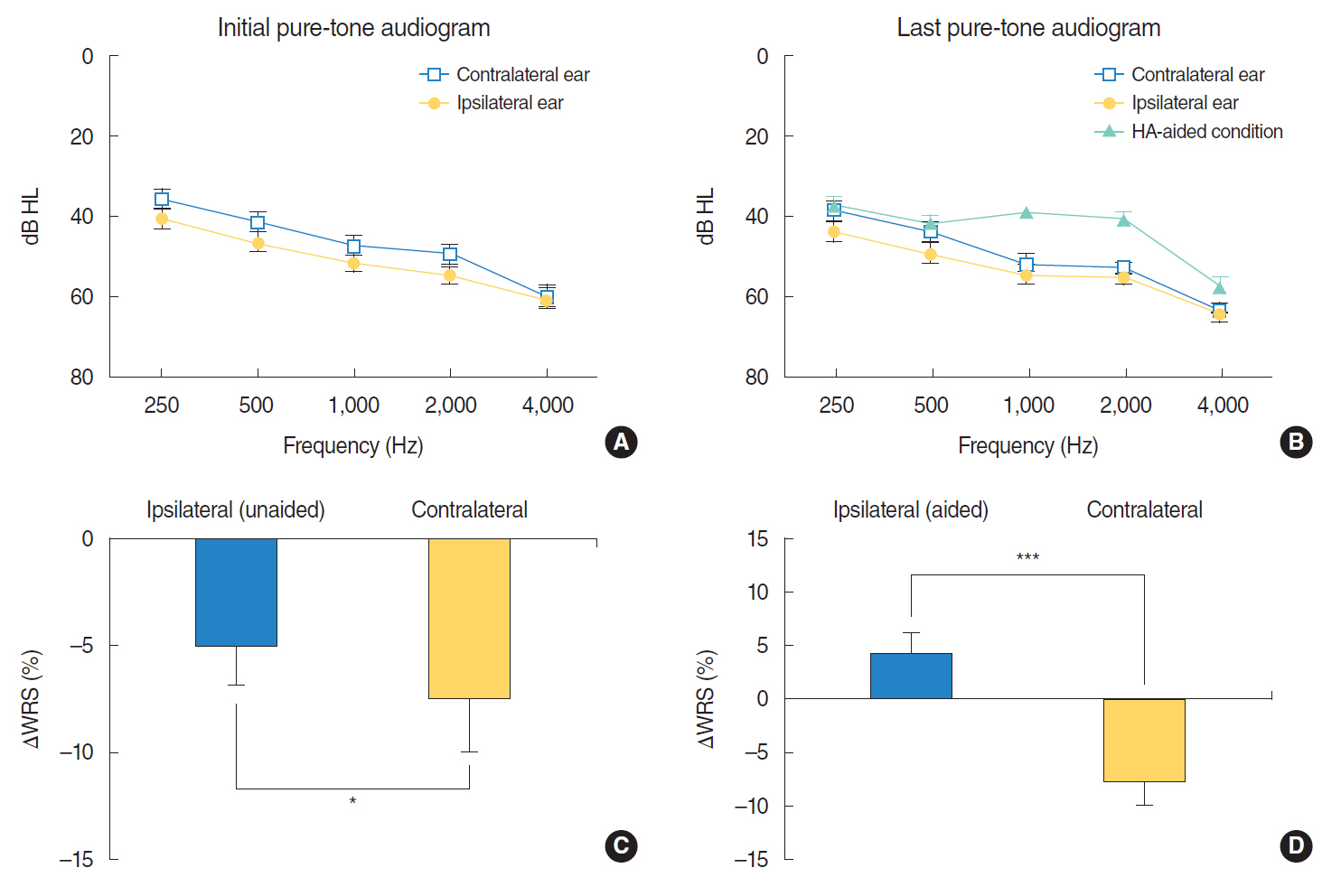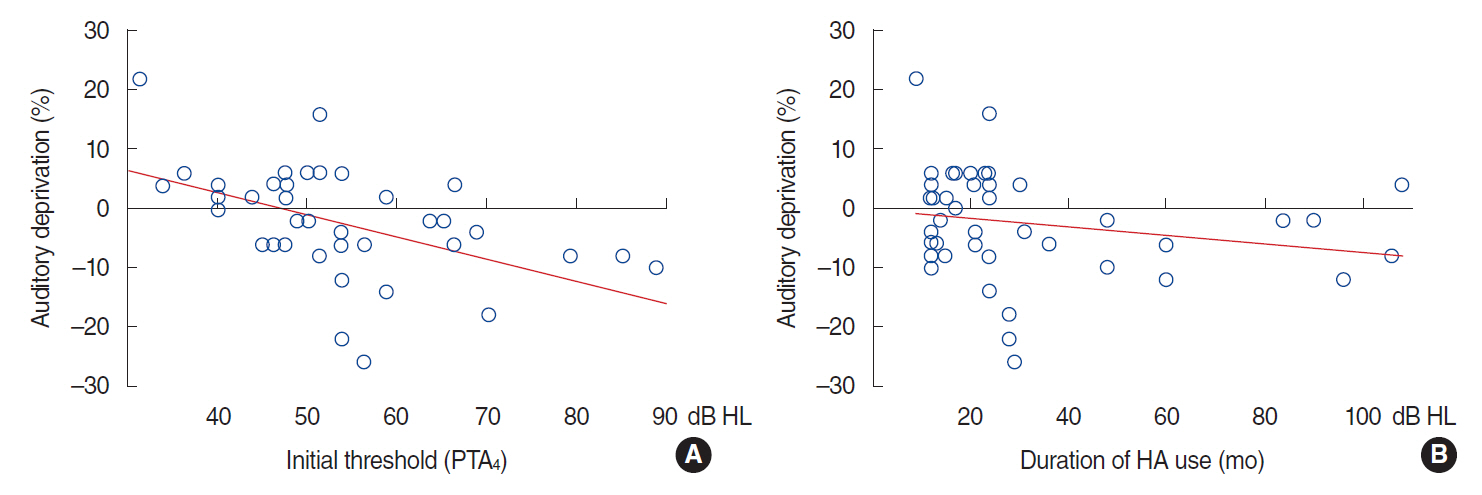Clin Exp Otorhinolaryngol.
2020 Feb;13(1):23-28. 10.21053/ceo.2019.00402.
Which Patients With a Unilateral Hearing Aid for Symmetric Sensorineural Hearing Loss Have Auditory Deprivation?
- Affiliations
-
- 1Department of Otorhinolaryngology, Yonsei University College of Medicine, Seoul, Korea
- 2Department of Otorhinolaryngology-Head and Neck Surgery, Incheon St. Mary’s Hospital, College of Medicine, The Catholic University of Korea, Seoul, Korea
- 3Department of Otorhinolaryngology, Ilsan Paik Hospital, Inje University College of Medicine, Goyang, Korea
- KMID: 2501293
- DOI: http://doi.org/10.21053/ceo.2019.00402
Abstract
Objectives
. The aim of study is to find conditions that aggravate auditory deprivation in patients with symmetric hearing loss after unilateral digital, non-linear hearing aid (HA).
Methods
. In the retrospective case-comparison study, we assessed 47 patients with symmetric sensorineural hearing loss (SNHL), wearing unilateral conventional HAs. Audiological outcomes were assessed >1 year after HA fitting (mean duration, 31.0 months). Pure-tone audiometry in HA-aided and HA-unaided conditions was performed over time. Word recognition score (WRS) was evaluated at the most comfortable listening level.
Results
. The initial pure tone average of four frequency thresholds at 500, 1,000, 2,000, and 4,000 Hz (PTA4) did not show a difference of >5 dB HL between HA-aided and HA-unaided ears. WRS progressively decreased for both HA-aided and HA-unaided ears although the extent of decrease was significantly greater for HA-unaided (7.6%) than for HA-aided ears (5.1%, P<0.05). Notably, auditory deprivation in HA-unaided ears was significantly greater in patients with an initial PTA4 ≥53 dB HL (P<0.001).
Conclusion
. Bilateral HAs are strongly recommended, particularly for patients with moderate to severe SNHL to prevent auditory deprivation in the contralateral ear.
Keyword
Figure
Cited by 2 articles
-
Increased Risk of Psychopathological Abnormalities in Subjects With Unilateral Hearing Loss: A Cross-Sectional Study
Jae-Jin Song, Eu Jeong Ku, Seoyoung Kim, Euitae Kim, Young-Seok Choi, Hahn Jin Jung
Clin Exp Otorhinolaryngol. 2021;14(1):82-87. doi: 10.21053/ceo.2020.00283.Hearing Impairment Increases Economic Inequality
So Young Kim, Chanyang Min, Dae Myoung Yoo, Jiwon Chang, Hyo-Jeong Lee, Bumjung Park, Hyo Geun Choi
Clin Exp Otorhinolaryngol. 2021;14(3):278-286. doi: 10.21053/ceo.2021.00325.
Reference
-
1. Cruickshanks KJ, Wiley TL, Tweed TS, Klein BE, Klein R, Mares-Perlman JA, et al. Prevalence of hearing loss in older adults in Beaver Dam, Wisconsin. The Epidemiology of Hearing Loss Study. Am J Epidemiol. 1998; Nov. 148(9):879–86.
Article2. Johnson CE, Danhauer JL, Ellis BB, Jilla AM. Hearing aid benefit in patients with mild sensorineural hearing loss: a systematic review. J Am Acad Audiol. 2016; Apr. 27(4):293–310.
Article3. Arlinger S. Negative consequences of uncorrected hearing loss: a review. Int J Audiol. 2003; Jul. 42 Suppl 2:2S17–20.4. Silverman CA, Emmer MB. Auditory deprivation and recovery in adults with asymmetric sensorineural hearing impairment. J Am Acad Audiol. 1993; Sep. 4(5):338–46.5. Silman S, Gelfand SA, Silverman CA. Late-onset auditory deprivation: effects of monaural versus binaural hearing aids. J Acoust Soc Am. 1984; Nov. 76(5):1357–62.
Article6. Silman S, Silverman CA, Emmer MB, Gelfand SA. Adult-onset auditory deprivation. J Am Acad Audiol. 1992; Nov. 3(6):390–6.7. Martin FN, Forbis NK. The present status of audiometric practice: a follow-up study. ASHA. 1978; Jul. 20(7):531–41.8. Silverman CA, Silman S, Emmer MB, Schoepflin JR, Lutolf JJ. Auditory deprivation in adults with asymmetric, sensorineural hearing impairment. J Am Acad Audiol. 2006; Nov-Dec. 17(10):747–62.
Article9. Murray DJ, Hanson JV. Application of digital signal processing to hearing aids: a critical survey. J Am Acad Audiol. 1992; Mar. 3(2):145–52.10. Keidser G, Dillon H, Flax M, Ching T, Brewer S. The NAL-NL2 prescription procedure. Audiol Res. 2011; Mar. 1(1):e24.
Article11. Han TH, Park CI. A study on standardization of Korean PB word list for speech audiometry. Korean J Otorhinolaryngol Head Neck Surg. 1981; 24(3):265–72.12. Gelfand SA, Silman S. Apparent auditory deprivation in children: implications of monaural versus binaural amplification. J Am Acad Audiol. 1993; Sep. 4(5):313–8.13. Gelfand SA, Silman S, Ross L. Long-term effects of monaural, binaural and no amplification in subjects with bilateral hearing loss. Scand Audiol. 1987; 16(4):201–7.
Article14. Hurley RM. Onset of auditory deprivation. J Am Acad Audiol. 1999; Nov-Dec. 10(10):529–34.15. Byrne D, Noble W, LePage B. Effects of long-term bilateral and unilateral fitting of different hearing aid types on the ability to locate sounds. J Am Acad Audiol. 1992; Nov. 3(6):369–82.16. Gatehouse S. The time course and magnitude of perceptual acclimatization to frequency responses: evidence from monaural fitting of hearing aids. J Acoust Soc Am. 1992; Sep. 92(3):1258–68.
Article17. Hattori H. Ear dominance for nonsense-syllable recognition ability in sensorineural hearing-impaired children: monaural versus binaural amplification. J Am Acad Audiol. 1993; Sep. 4(5):319–30.18. van Schoonhoven J, Schulte M, Boymans M, Wagener KC, Dreschler WA, Kollmeier B. Selecting appropriate tests to assess the benefits of bilateral amplification with hearing aids. Trends Hear. 2016; Jul. 20:2331216516658239.
Article19. Boymans M, Goverts ST, Kramer SE, Festen JM, Dreschler WA. A prospective multi-centre study of the benefits of bilateral hearing aids. Ear Hear. 2008; Dec. 29(6):930–41.
Article20. Chisolm TH, Willott JF, Lister JJ. The aging auditory system: anatomic and physiologic changes and implications for rehabilitation. Int J Audiol. 2003; Jul. 42 Suppl 2:2S3–10.
Article21. Bentler RA, Niebuhr DP, Getta JP, Anderson CV. Longitudinal study of hearing aid effectiveness. I: objective measures. J Speech Hear Res. 1993; Aug. 36(4):808–19.
- Full Text Links
- Actions
-
Cited
- CITED
-
- Close
- Share
- Similar articles
-
- Rehabilitation of Sensorineural Hearing Loss: Hearing Aid
- A Case of Dolichoectasia of Vertebrobasilar Artery Presenting Simultaneous Bilateral Sudden Sensorineural Hearing Loss with Vertigo
- Hearing Impairment Simulation for the Performance Evaluation of Hearing Aid
- Update on the Management for Sensorineural Hearing Loss in Children
- Stem Cell Therapy for Sensorineural Hearing Loss, Still Alive?




